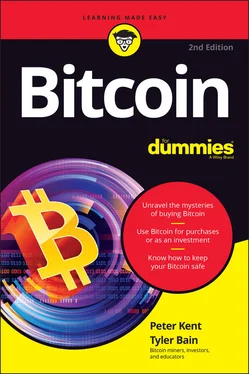But we’re here to talk about Bitcoin, so let’s begin with a little history. Where did Bitcoin come from, and how did it develop?
In the Beginning, There Were … Digital Currencies?
Blockchain-based cryptocurrencies are pretty new, but digital currencies designed for use online have been around for quite a while. (Don’t worry about this blockchain thing for the moment; we explain that in not-too-mind-numbing detail in Chapter 2. Just understand for now that a blockchain is a special kind of database, a store of digital data.)
As people started flooding online — the process began in the early 1980s, but really took off in 1994 with the advent of the commercial Internet — it became clear that they were going to need some way to spend money in cyberspace (the first Internet stores opened in that year). Of course, most online transactions today use credit and debit cards — even PayPal and Venmo are essentially enabling such transactions, along with bank transfers — but that wasn’t the case in the early days. Many people were concerned about credit-card theft and thus wary of using their numbers online, for instance. (When co-author Peter opened an online store in 1997, he did have a functioning credit-card gateway, but many customers would print out a paper order form and mail a check!)
There was also the issue of microtransactions . Surely, in the digital world, it should be possible to pay someone, say, five or ten cents for something, such as access to a video or article. The microtransaction problem has still not been solved (though one might argue that the Bitcoin Lightning network, which we discuss in Chapter 4, almost gets us there), but nonetheless, that’s one of the ideas that drove the development of digital currencies.
And develop they did. In 1983 David Chaum wrote a research paper on the concept of digital currency ( Blind Signatures for Untraceable Payments ), suggesting the use of cryptography to create and manage a digital currency. So even back then, cryptography had a role in digital currencies, although they weren’t known as cryptocurrencies back then. When you hear people talk about cryptocurrencies , they are generally talking about this new generation of blockchain-based cryptocurrencies that started with Bitcoin. (We explain more about cryptography and how it relates to cryptocurrencies in Chapter 2.)
Chaum actually launched a cryptography-based digital currency, known as DigiCash , in 1990, but these were still very early days. Very few people were online in 1990, and the currency died out by around 1998. What likely hurt digital currencies by the end of the ’90s was that the credit-card companies wanted a piece of the online action, and thus went out of their way to assuage consumers’ fears of using credit cards online.
Still other digital currencies came along. There was e-gold, a currency backed by real gold, and Millicent, a currency created by a major computing company, Digital Equipment Corporation (DEC). (If you’re younger than, say, mid-thirties, you probably won’t remember DEC, but it was a big deal. In fact, even IBM had a micropayments division working on digital currencies at the time.)
Then there was NetBill, a project of Carnegie Mellon University, which was later merged into another system, CyberCash, which eventually ended up in the clutches of PayPal. There was Beenz, which had a partnership with MasterCard at one point, First Virtual, CyberCoin, Flooz (promoted by Whoopi Goldberg, no less!), and various others.
But nothing much stuck . Lots of great ideas, but nobody could quite make it all work . By the early 2000s, most of these endeavors were moribund (probably ushered along by the dotcom crash of late 2000). There were exceptions. Liberty Reserve, based in Costa Rica, ran from 2006 until 2013, but was shut down after accusations that it was being used to launder billions of dollars of criminal proceeds. And closed systems that work on particular networks, such as China’s QQ Coins, are mostly used on the Tencent QQ Messaging service.
But then, there was Satoshi Nakamoto and his magical blockchain.
On November 1, 2008, someone named Satoshi Nakamoto posted a message to a cryptography forum, titled Bitcoin P2P e-cash paper (archived at https://www.mail-archive.com/cryptography@metzdowd.com/msg09959.html ). In his message, Nakamoto announced that he had “been working on a new electronic cash system that's fully peer-to-peer, with no trusted third party.”
In other words, he’d created a currency system that worked on a network of peers — computers working together with each equal to the other. With no central power required, no bank or government to act as a “trusted third party” was required.
A comment he made in the post explained his view of the problem with the earlier cryptocurrencies. “A lot of people automatically dismiss e-currency as a lost cause because of all the companies that failed since the 1990s,” he said. He believed that these other digital-money systems had a critical weakness, an Achilles heel. “I hope it’s obvious it was only the centrally controlled nature of those systems that doomed them. I think this is the first time we’re trying a decentralized, non-trust-based system.”
 Nakamoto had previously set up a domain name and a simple website, bitcoin.org, and there he posted a document explaining how all this would work:
Nakamoto had previously set up a domain name and a simple website, bitcoin.org, and there he posted a document explaining how all this would work: https://bitcoin.org/bitcoin.pdf . You might want to take a quick look, though it’s not essential for your understanding of Bitcoin (it’s pretty geeky stuff).
The whitepaper he posted describes how a blockchain (a special form of database) could be used to manage the currency. Essentially, the blockchain records a ledger, a record of currency transactions, and because the blockchain is duplicated over numerous computers (the peers) and because these peers are all equal, no trust in a central party is required. You may hear Bitcoin described as a “trustless” system. That doesn’t mean it can’t be trusted; it means that a trusted third party is not required. The trust, in effect, is baked into the system. The mathematics — or mathemagics, as Peter likes to call it — which powers the system means that Bitcoin transactions can be trusted, even without a central “power” overseeing the system. (See Chapter 2for an explanation of why.)
 Satoshi Nakamoto (whoever he, she, or it is) didn’t use the words cryptocurrency, blockchain, or trustless anywhere in the whitepaper. Those are terms that others applied to the system later.
Satoshi Nakamoto (whoever he, she, or it is) didn’t use the words cryptocurrency, blockchain, or trustless anywhere in the whitepaper. Those are terms that others applied to the system later.
The idea of blockchain had actually been around for a while — at least since 1991 — in fact, remember David Chaum of DigiCash fame? He had been working with the idea of a blockchain since the early 1990s.
Anyway, Nakamoto didn’t stop there. In January of 2009, he/she/it launched the Bitcoin network. Nakamoto released some thirty-thousand lines of code that defined the network protocols and processes necessary to operate this peer-to-peer, decentralized money system. And Bitcoin was born.
Of course, in January of 2009, Bitcoin had essentially no value. Still, the genesis block created by Nakamoto (the very first block of data in the blockchain creating the first 50 Bitcoins), along with subsequent blocks of data “mined” by Nakamoto (see Chapter 7), comprise perhaps a million Bitcoins: At current prices, that’s $47,369,000,000. Yes, close to 50 billion dollars!
Читать дальше

 Nakamoto had previously set up a domain name and a simple website, bitcoin.org, and there he posted a document explaining how all this would work:
Nakamoto had previously set up a domain name and a simple website, bitcoin.org, and there he posted a document explaining how all this would work:  Satoshi Nakamoto (whoever he, she, or it is) didn’t use the words cryptocurrency, blockchain, or trustless anywhere in the whitepaper. Those are terms that others applied to the system later.
Satoshi Nakamoto (whoever he, she, or it is) didn’t use the words cryptocurrency, blockchain, or trustless anywhere in the whitepaper. Those are terms that others applied to the system later.










